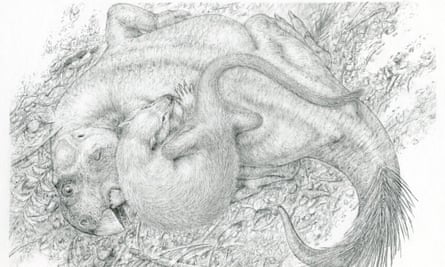Whether they had sharp teeth, vicious claws or were simply enormous, dinosaurs were creatures to be feared. But a newly identified fossil shows that, at least sometimes, the underdog bit back.
Experts revealed the 125m-year-old fossil that froze in time after being taken on by a small mammal a third of its size. They are tangled together, the mammal’s teeth sunk into the beaked dinosaur’s ribs, its left paw clasping the beast’s lower jaw.
Researchers said the discovery challenged a long-held view of early mammals as “fodder” for dinosaurs.
Dr Jordan Mallon, a co-author of the study, based at the Canadian Museum of Nature, said: “This new fossil teaches us that in the Mesozoic ‘age of dinosaurs’, dinosaurs were not always king. Even the smaller mammals could pose a threat, foreshadowing their rise to dominance 66m years ago.”
The fossilised mammal, discovered in the Lujiatun member of the Lower Cretaceous Yixian formation in China in May 2012, was identified by the team as Repenomamus robustus – an ancient creature about the size of a domestic cat. The victim of its attack was Psittacosaurus lujiatunensis, a bipedal, plant-eating beaked dinosaur – and a distant relative to the later triceratops – which was about the size of a cocker spaniel.
The authors of the study, published in the journal Scientific Reports, said neither creature was a full-grown adult at the time of its death, adding that the grappling animals appeared to have been killed in a natural disaster as the mammal attempted to tackle the dinosaur.
“The lack of bite marks on the dinosaur skeleton, the position of the mammal atop the dinosaur, and the grasping and biting actions of the mammal, collectively signal that the mammal was preying on the weakened dinosaur when the two were suddenly entombed by a volcanic debris flow,” they wrote.
The researchers said their calculations suggested that it would have been possible for the mammal to attempt to prey on such a dinosaur, noting that mammals including wolverines are known to occasionally hunt much larger creatures, including caribou, on their own.
It is not the first time that fossil hunters have found mammals turning the tables on dinosaurs. In 2005, researchers discovered a fossil of Repenomamus robustus with the remains of a young Psittacosaurus in its stomach from the same part of China.
Prof Steve Brusatte, a palaeontologist at the University of Edinburgh, who was not involved in the new discovery, said he was flabbergasted by the fossil.

“Preserving a chunk of bone for 125m years is hard enough, and preserving a skeleton of a dinosaur is even tougher, but capturing two animals locked in combat, it seems miraculous,” he said. “It does seem like this is a prehistoric hunt, captured in stone, like a freeze frame. And this turns the old story on its head. We’re used to thinking of the age of dinosaurs as a time when dinosaurs ruled the world, and the tiny mammals cowered in the shadows. But here is a mammal that seems to be eating a dinosaur.”
While the authors acknowledge that fossil forgeries have previously been reported, they say it is unlikely to be the case here, not least because the two skeletons are entwined. They also undertook to test the fossil’s authenticity by exposing the left lower jaw of the mammal – which had not been revealed before – and found it “plunges into the matrix to clasp the dinosaur’s ribs”.
But Brusatte said there remained some legitimate concerns about the integrity of the fossil. “There have been doctored fossils from this part of the world before, and the scientists did not dig up this specimen themselves. The skeletons are no doubt genuine, but I suppose the poses of the bones could have been altered, although I have no direct evidence for this,” he said.
“As more scientists are able to study the fossil, I hope this doubt can be put to rest.”

